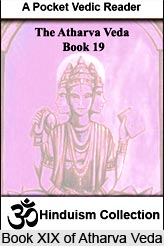 Hymns in Book XIX of Atharva Veda starts with a prayer that is an accompaniment to
the offering of a mixed oblation. The following two hymns are hymns to waters and Agni
for safety and prosperity. The next two hymns are prayers for accompanying sacrifice,
attainment of a wish and for riches. The sixth hymn is on mystical sacrifice of Purusha.
The seventh hymn is a prayer to the lunar mansions and other powers for protection and
prosperity. The eighth hymn is a hymn to the sun and other heavenly bodies for defence
and affluence. The ninth and the tenth hymns are prayers for protection and prosperity in
general.
Hymns in Book XIX of Atharva Veda starts with a prayer that is an accompaniment to
the offering of a mixed oblation. The following two hymns are hymns to waters and Agni
for safety and prosperity. The next two hymns are prayers for accompanying sacrifice,
attainment of a wish and for riches. The sixth hymn is on mystical sacrifice of Purusha.
The seventh hymn is a prayer to the lunar mansions and other powers for protection and
prosperity. The eighth hymn is a hymn to the sun and other heavenly bodies for defence
and affluence. The ninth and the tenth hymns are prayers for protection and prosperity in
general.
The eleventh hymn is a continuation of the tenth Hymn. The next two hymns are prayers
to dawn for wealth and long life as well as help and win in battle. The next one is a hymn
post victory. Next four hymns are prayers for peace and security. The nineteenth hymn
recommends protection for various gods. Twentieth hymn is also a prayer for safety from
disaster and death. The twenty first hymn gives the names of major Vedic metres. The
following hymn is a prose hymn which is homage to various portions of the Atharva
Veda, to the Rishis and to Brahma. A prose hymn of homage to various portions of the
Atharva Veda is the twenty third hymn. The subsequent hymn is a blessing on a King
who has been elected newly. The twenty fifth hymn is a charm that has to be used when a
young ox is yoked first. The succeeding hymn is an accompaniment investiture with a
golden amulet. The following hymn is a blessing hymn. Next two hymns are charms for
destruction of enemies. The thirtieth hymn is a charm supplementing investiture with a
Darbha grass amulet.
The subsequent two hymns are charms seeking prosperity and subduing of enemies. The
following seven hymns are charms for blessings, protection, long life and against evil
spirits. The fortieth hymn is a prayer for pardon of error in sacrifice as well as for
wisdom, strength and life. The next hymn is a blessing on a newly elected king. The
subsequent two hymns are in praise of Brahma. Again the next two hymns are protective
charms. The forty sixth hymn is a charm accompanying investiture with an amulet that
would ensure security and victory. The following four hymns are to night for safety frm
fearful animals. The fifty first one is a sacrificial formula. The next five hymns are to
Kama, Agni as well as to sleep for protection and prosperity. The fifty seventh hymn is a
charm against evil dreams. A prayer for success forms the next hymn. The fifty ninth
hymn is an expiatory hymn accompanying sacrifice. The sixtieth hymn is a prayer for
perfect bodily and mental health and vigour.
The next four hymns are prayers for long life and success final happiness in heaven, to
Agni for children. The next two hymns are to Agni. The sixty seventh hymn is a prayer
for long life. The sixty eighth hymn is an initial sacrificial formula. The subsequent two
hymns are prayers for long life. The seventy first hymn accompanies libations, for wealth
and prosperity. The last hymn is a sacrificial formula.



















